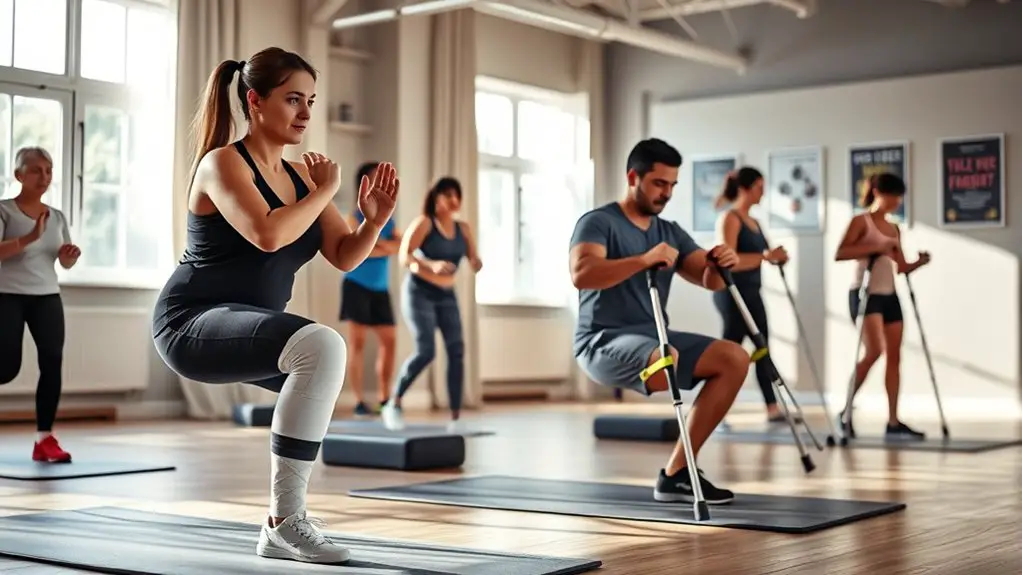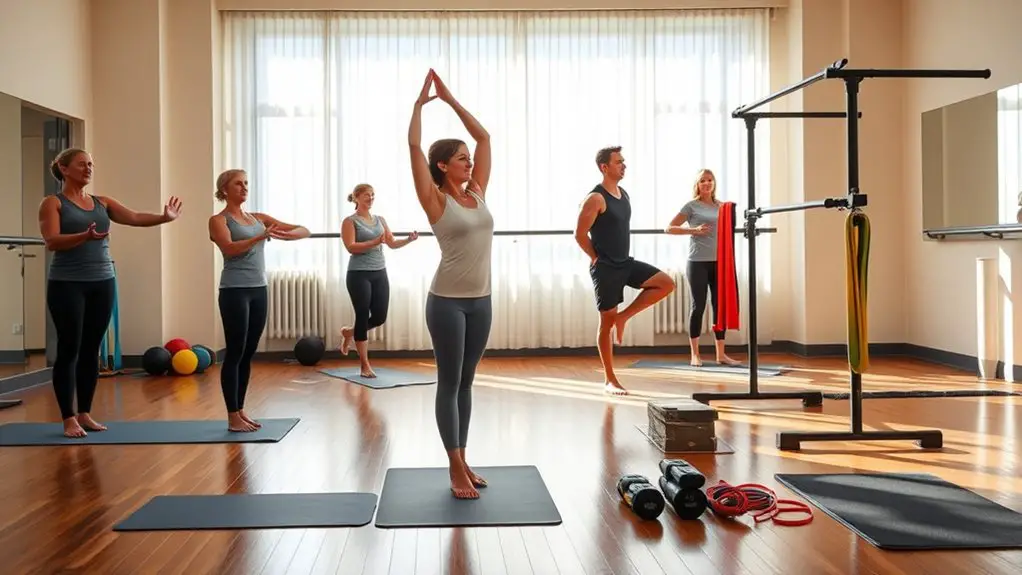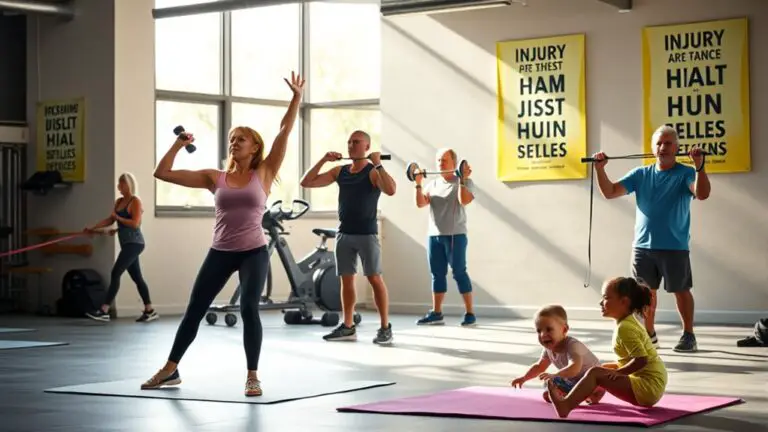The Best Gym Exercises for Post-Surgery Recovery

After surgery, it’s essential to engage in exercises that support your recovery. Start with gentle stretching to enhance flexibility and circulation. Low-impact cardio like walking or stationary cycling can boost cardiovascular health without straining your body. Gradually incorporate strength training and core stabilization exercises, such as pelvic tilts and controlled squats. Resistance bands can effectively build strength while you monitor your progress. For tailored recommendations and safe practices, there’s more to explore on optimizing your recovery journey.
Understanding Your Recovery Timeline

When you undergo surgery, understanding your recovery timeline is essential for setting realistic expectations and optimizing your rehabilitation. Recovery milestones serve as important markers to track your progress through various healing stages. Initially, you’ll likely focus on pain management and basic mobility, which are critical for laying the groundwork for your recovery.
As you move through the first few weeks, you’ll reach milestones like resuming light activities and gradually increasing your range of motion. It’s important to listen to your body and recognize that recovery isn’t linear; some days may feel better than others.
Importance of Consulting Your Healthcare Provider
Consulting your healthcare provider is essential for developing a personalized recovery plan tailored to your specific needs. They can offer safe exercise guidelines that take into account your surgery and overall health status. This guarantees that your return to the gym is both effective and safe, minimizing the risk of complications.
Personalized Recovery Plans
While starting your post-surgery recovery journey, it is crucial to recognize the importance of a personalized recovery plan tailored to your specific needs. Consulting with your healthcare provider allows for personalized assessments that identify your unique physical condition and recovery goals. These assessments help determine which tailored exercises are safe and effective for your situation. By engaging in a structured plan, you can address any limitations and gradually rebuild strength without risking further injury. Remember, each recovery process is different, so what works for someone else may not be suitable for you. Prioritizing a customized approach guarantees you’re making progress at a pace that aligns with your healing process, ultimately supporting a more successful recovery.
Safe Exercise Guidelines
Before commencing any exercise regimen post-surgery, it is essential to involve your healthcare provider in the decision-making process. They can help tailor rehabilitation techniques to your specific needs and guarantee that your exercise modifications are safe and effective. Here are some guidelines to keep in mind:
- Discuss your surgery and recovery timeline
- Identify any restrictions or precautions
- Determine appropriate rehabilitation techniques
- Create a balanced exercise plan
- Monitor your progress and adjust as needed
Consulting your healthcare provider not only enhances your safety but also empowers you to recover responsibly. By following their recommendations, you’ll be more likely to return to your pre-surgery fitness level while minimizing the risk of complications.
Gentle Stretching Exercises

Gentle stretching exercises play an essential role in post-surgery recovery, as they help maintain flexibility and promote circulation to the affected areas. Incorporating gentle yoga and mobility exercises into your routine can greatly aid in restoring movement without overexertion.
Start with basic stretches, focusing on the muscles surrounding the surgical site. For instance, seated forward bends and gentle side stretches can enhance flexibility in your back and hips. Always listen to your body; if something feels uncomfortable, ease off.
Engaging in gentle yoga can also improve your mental well-being, providing a calming effect during recovery. Aim for short sessions, gradually increasing duration as your strength improves. Remember, consistency is key; even a few minutes daily can yield considerable benefits.
Consult your healthcare provider before starting any new exercise regimen to verify it’s safe for your specific situation. Prioritizing gentle stretching can set a solid foundation for your overall recovery.
Low-Impact Cardio Options
Incorporating low-impact cardio options into your post-surgery recovery can greatly enhance your cardiovascular health without placing undue stress on your body. These activities help improve circulation and boost your overall well-being. Here are some effective options to evaluate:
- Walking workouts: Start with short, gentle walks, gradually increasing duration and pace.
- Stationary cycling: Use a recumbent bike for added support while still engaging your legs.
- Elliptical machine: This provides a smooth motion that reduces impact on joints.
- Water aerobics: The buoyancy of water offers resistance without strain, ideal for recovery.
- Rowing machine: A low-impact choice that works multiple muscle groups while being easy on your body.
Incorporating activities like skipping rope can also provide aerobic exercise benefits that enhance your recovery process. Always listen to your body and consult with your healthcare provider before starting any new exercise regime. These low-impact options can help you regain strength and mobility effectively.
Strength Training for Rehabilitation

Strength training plays an essential role in your rehabilitation process after surgery. Focusing on controlled movements guarantees you build strength safely, while progressive resistance techniques help you gradually enhance your capabilities. This approach not only supports recovery but also helps prevent future injuries.
Importance of Controlled Movements
While you may feel keen to resume your regular workout routine after surgery, it’s crucial to prioritize controlled movements during your rehabilitation. Focusing on these movements offers significant controlled movement benefits, such as minimizing pain and enhancing recovery. Incorporating injury prevention strategies in your exercises can lead to safer outcomes. Think about:
- Smooth, deliberate squats that engage your core
- Slow, measured lunges that build strength safely
- Gentle arm raises that improve flexibility
- Careful step-ups to enhance stability
- Controlled planks to reinforce core strength
Each of these exercises emphasizes precision and focus, helping you regain strength without risking further injury. Remember, the goal is to heal effectively, so patience and control are paramount in this phase of recovery.
Progressive Resistance Techniques
After establishing a foundation of controlled movements, it’s time to introduce progressive resistance techniques into your rehabilitation. These techniques focus on progressive overload, gradually increasing the resistance to strengthen your muscles safely. Start with light weights or resistance bands, ensuring you maintain proper form. As you become comfortable, incorporate resistance variations, such as changing angles or using different equipment, to target various muscle groups and improve functional strength. Monitor your body’s response closely; if you experience pain beyond normal discomfort, reduce the weight or volume. This gradual increase helps prevent injury while promoting recovery. Remember, the goal is to rebuild strength over time, so listen to your body and adjust your approach as needed for best results.
Balance and Stability Exercises
Balance and stability exercises play an essential role in post-surgery recovery, helping you regain control and coordination in your movements. Incorporating balance training and stability drills into your routine can greatly enhance your rehabilitation process. These exercises not only improve your physical stability but also boost your confidence in performing daily tasks.
Consider including the following exercises:
- Standing on one leg while holding onto a stable surface
- Heel-to-toe walking along a straight line
- Using a balance board to challenge your stability
- Performing side leg raises to engage your hip muscles
- Practicing Tai Chi for fluid movement and balance
Core Strengthening Movements

Regaining core strength is essential for a successful post-surgery recovery, as it helps stabilize your entire body and supports proper movement patterns. Focus on exercises that promote core stability and enhance pelvic alignment, guaranteeing a balanced recovery process.
| Exercise | Description | Benefits |
|---|---|---|
| Pelvic Tilts | Lie on your back, knees bent, tilt pelvis up and down. | Improves pelvic alignment, engages lower abs. |
| Bird-Dog | On hands and knees, extend opposite arm and leg. | Enhances balance, strengthens core stability. |
| Dead Bug | Lie on your back, lift legs and arms, lower one side at a time. | Builds coordination, stabilizes core and pelvis. |
Incorporating these movements into your routine can greatly aid in regaining strength. Always consult your healthcare provider before starting new exercises to guarantee they’re suitable for your specific recovery needs.
Resistance Band Workouts
Resistance band workouts are an excellent option for your post-surgery recovery, offering numerous benefits such as improved strength and flexibility without putting excessive strain on your body. These bands allow for a range of effective exercises that can be easily modified to suit your current fitness level. Incorporating resistance bands into your routine can help facilitate a safe and gradual return to activity.
Benefits of Resistance Bands
While you may be keen to resume your fitness routine after surgery, incorporating resistance bands into your workouts can provide significant benefits for your recovery. The resistance band versatility allows you to perform various exercises tailored to your specific needs, enhancing strength and flexibility. Here are some notable resistance band benefits:
- Improved muscle engagement during rehabilitation.
- Gradual resistance adjustment, preventing overexertion.
- Compact and portable design, easy to use anywhere.
- Low-impact workouts that minimize joint strain.
- Versatile application for multiple muscle groups.
Effective Band Exercises
Incorporating effective band exercises into your post-surgery recovery can considerably enhance your rehabilitation process. Resistance bands allow you to gradually build band strength while accommodating your current physical limitations. Start with low resistance variations, focusing on controlled movements to avoid strain. Target major muscle groups through exercises like seated rows, lateral raises, and leg presses. These movements not only strengthen but also improve flexibility and stability. As you progress, you can increase resistance to guarantee continued improvement. Always listen to your body, and consult your healthcare provider before starting any new exercise regimen. Remember, the goal is to regain strength safely and efficiently, paving the way for a full recovery.
Incorporating Flexibility Training

As you recover from surgery, incorporating flexibility training into your routine can greatly enhance your healing process. This training not only improves your range of motion but also aids in reducing stiffness. Consider integrating dynamic stretching and yoga into your regimen. These practices promote gentle movement and relaxation, essential for recovery.
Incorporating flexibility training post-surgery enhances healing, improves range of motion, and reduces stiffness through gentle movement and relaxation.
- Gentle arm circles to open shoulders
- Standing quad stretches for leg flexibility
- Seated forward bends to elongate the spine
- Cat-cow stretches for spinal mobility
- Child’s pose for relaxation and breathing
Monitoring Your Progress and Adjusting Your Routine
Monitoring your progress and adjusting your routine is essential for guaranteeing a safe and effective recovery after surgery. Regular progress tracking allows you to evaluate how your body responds to different exercises, helping you identify what works best for you. Keep a log of your workouts, noting any changes in strength, endurance, and flexibility. This data is invaluable for making informed decisions about your recovery plan.
As you track your progress, don’t hesitate to make routine adjustments. If an exercise causes discomfort or doesn’t yield results, modify it or replace it with an alternative that aligns better with your current abilities. Consult with your healthcare provider or a physical therapist to guarantee your adjustments are appropriate. Remember, recovery isn’t linear; being flexible with your routine will help you stay motivated and engaged in your rehabilitation journey. Embrace these changes as part of your recovery process.
Frequently Asked Questions
What Are the Signs of Overexertion During Recovery Exercises?
Imagine pushing through a thick fog; if you feel excessive fatigue, breathlessness, or sharp pain, those’re your body’s recovery indicators. Listen closely to these signs; they’re essential to avoiding setbacks during your healing journey.
How Long Should I Wait Before Starting Gym Exercises?
You should wait until your recovery timeline allows for gentle movements. Consult your healthcare provider for personalized advice, but typically, light exercises can begin within weeks, depending on your individual progress and healing status.
Can I Do Exercises if I Experience Pain?
If you’re experiencing pain, it’s essential to listen to your body. Gentle stretching can aid in pain management, but always consult your healthcare provider to guarantee you’re exercising safely and appropriately during recovery.
What Should I Wear to the Gym During Recovery?
During recovery, you should wear comfortable attire that allows for ease of movement and supportive footwear to protect your feet and provide stability. Prioritizing comfort can enhance your experience and promote safer exercise engagement.
Are There Any Specific Gym Machines I Should Avoid?
Imagine a fragile flower needing gentle care. In your recovery, avoid machines that strain your body, like heavy leg presses or overhead presses. Prioritize recovery equipment and guarantee machine safety to foster healing. Your patience pays off.





